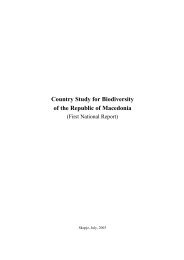Guidelines for the Rapid Ecological Assessment - Convention on ...
Guidelines for the Rapid Ecological Assessment - Convention on ...
Guidelines for the Rapid Ecological Assessment - Convention on ...
Create successful ePaper yourself
Turn your PDF publications into a flip-book with our unique Google optimized e-Paper software.
GUIDELINES FOR THE RAPID ECOLOGICAL ASSESSMENT OF BIODIVERSITY IN INLAND WATER, COASTAL AND MARINE AREAS<br />
Choosing between distinct versus representative habitats often depends <strong>on</strong> <str<strong>on</strong>g>the</str<strong>on</strong>g> resources and purpose of<br />
<str<strong>on</strong>g>the</str<strong>on</strong>g> assessment. If time is short, it may be best to quickly survey representative areas in order to get a<br />
good general picture of <str<strong>on</strong>g>the</str<strong>on</strong>g> situati<strong>on</strong> be<str<strong>on</strong>g>for</str<strong>on</strong>g>e trying to assess more unique sites. If more time is available,<br />
and <str<strong>on</strong>g>the</str<strong>on</strong>g> purpose is to survey as many species as possible, or to describe habitat types, <str<strong>on</strong>g>the</str<strong>on</strong>g>n distinctive<br />
habitats may deserve more attenti<strong>on</strong>.<br />
C<strong>on</strong>siderati<strong>on</strong> should also be given to site accessibility, taking into account factors such as remoteness,<br />
restricti<strong>on</strong>s due to land use (e.g. military z<strong>on</strong>es), land tenure, susceptibility to flood/fire events, and seas<strong>on</strong>al/wea<str<strong>on</strong>g>the</str<strong>on</strong>g>r<br />
c<strong>on</strong>diti<strong>on</strong>s.<br />
7.3 Sampling and data analysis<br />
The type of sampling method used is determined according to <str<strong>on</strong>g>the</str<strong>on</strong>g> objective of <str<strong>on</strong>g>the</str<strong>on</strong>g> assessment and<br />
should be more or less <str<strong>on</strong>g>the</str<strong>on</strong>g> same <str<strong>on</strong>g>for</str<strong>on</strong>g> all nati<strong>on</strong>s, including small island states. The sampling methods<br />
used will vary according to <str<strong>on</strong>g>the</str<strong>on</strong>g> need to be standardized, whe<str<strong>on</strong>g>the</str<strong>on</strong>g>r <str<strong>on</strong>g>the</str<strong>on</strong>g>y can or cannot be technical, <str<strong>on</strong>g>the</str<strong>on</strong>g><br />
time limitati<strong>on</strong>s, and <str<strong>on</strong>g>the</str<strong>on</strong>g> type of equipment available. Most importantly, <str<strong>on</strong>g>the</str<strong>on</strong>g> methods should strive to<br />
provide insightful, statistically sound data that can be applied to <str<strong>on</strong>g>the</str<strong>on</strong>g> purpose of <str<strong>on</strong>g>the</str<strong>on</strong>g> assessment.<br />
For most studies, a variety of water quality variables should be measured. These can include temperature,<br />
electrical c<strong>on</strong>ductivity (EC, a measure of <str<strong>on</strong>g>the</str<strong>on</strong>g> total dissolved salts), pH (an measure of <str<strong>on</strong>g>the</str<strong>on</strong>g> water’s<br />
acidity or alkalinity), chlorophyll A, total phosphorous, total nitrogen, dissolved oxygen, and water<br />
transparency (Secchi depth). These variables can be measured with individual instruments or with <strong>on</strong>e<br />
combinati<strong>on</strong> instrument that includes several types of probes.<br />
Macrophytes can be searched visually from above or under <str<strong>on</strong>g>the</str<strong>on</strong>g> water surface (scuba) or by means of special<br />
samplers. Fishes can be sampled using a wide variety of methods (see Appendix 2), keeping in mind<br />
<str<strong>on</strong>g>the</str<strong>on</strong>g> applicable legislati<strong>on</strong>. Asking local fishermen and examining <str<strong>on</strong>g>the</str<strong>on</strong>g>ir catches can be a helpful method<br />
as well. Aquatic invertebrates can be sampled from <str<strong>on</strong>g>the</str<strong>on</strong>g> water column (plankt<strong>on</strong>), from emergent, floating-leaved,<br />
and submerged vegetati<strong>on</strong> (epiphytic fauna), and from <str<strong>on</strong>g>the</str<strong>on</strong>g> bottom sediments (benthic invertebrates)<br />
by appropriate sampling technique. Reptiles and amphibians are generally sampled using nets,<br />
traps or by visual search during day and night.<br />
Appendix 2 lists a wide range of sampling methods <str<strong>on</strong>g>for</str<strong>on</strong>g> different wetland features and taxa which can be<br />
used in rapid assessments. Some o<str<strong>on</strong>g>the</str<strong>on</strong>g>r useful general reference sources <str<strong>on</strong>g>for</str<strong>on</strong>g> sampling methods include:<br />
Merritt et al (1996); James & Edis<strong>on</strong> (1979); Platts et al (1983); Nielsen & Johnst<strong>on</strong> (1996); and<br />
Su<str<strong>on</strong>g>the</str<strong>on</strong>g>rland (2000). Useful websites <str<strong>on</strong>g>for</str<strong>on</strong>g> reference include: <str<strong>on</strong>g>the</str<strong>on</strong>g> United States Envir<strong>on</strong>mental Protecti<strong>on</strong><br />
Agency (www.epa.gov/owow/m<strong>on</strong>itoring), <str<strong>on</strong>g>the</str<strong>on</strong>g> World C<strong>on</strong>servati<strong>on</strong> M<strong>on</strong>itoring Centre (www.unepwcmc.org),<br />
<str<strong>on</strong>g>the</str<strong>on</strong>g> World Biodiversity Database provided by <str<strong>on</strong>g>the</str<strong>on</strong>g> Expert Center <str<strong>on</strong>g>for</str<strong>on</strong>g> Tax<strong>on</strong>omic<br />
Identificati<strong>on</strong> (ETI) (www.eti.uva.nl), and <str<strong>on</strong>g>the</str<strong>on</strong>g> <str<strong>on</strong>g>Ecological</str<strong>on</strong>g> M<strong>on</strong>itoring and <str<strong>on</strong>g>Assessment</str<strong>on</strong>g> Network<br />
(Canada; http://www.eman-rese.ca/eman/intro.html).<br />
In <str<strong>on</strong>g>the</str<strong>on</strong>g> c<strong>on</strong>text of rapid assessment, data used should be of <str<strong>on</strong>g>the</str<strong>on</strong>g> appropriate type and quality <str<strong>on</strong>g>for</str<strong>on</strong>g> <str<strong>on</strong>g>the</str<strong>on</strong>g>ir<br />
intended use. If more resources are available in time, m<strong>on</strong>ey and expertise, <str<strong>on</strong>g>the</str<strong>on</strong>g> possibilities of obtaining<br />
reliable data and sound statistical results are higher. In additi<strong>on</strong>, it is important to ga<str<strong>on</strong>g>the</str<strong>on</strong>g>r pre-existing<br />
31
















